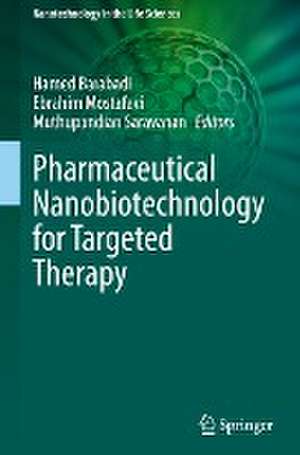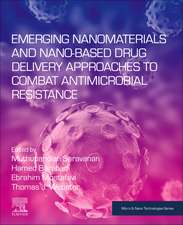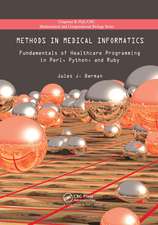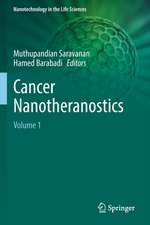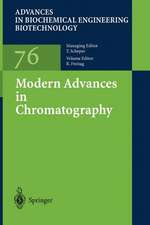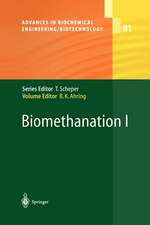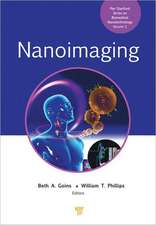Pharmaceutical Nanobiotechnology for Targeted Therapy: Nanotechnology in the Life Sciences
Editat de Hamed Barabadi, Ebrahim Mostafavi, Muthupandian Saravananen Limba Engleză Hardback – 19 oct 2022
Pharmaceutical Nanobiotechnology for Targeted Therapy presents an updated overview of recent advancements in the field of pharmaceutical nanobiotechnology and nano-based drug and gene delivery systems. This comprehensive knowledge willallow researchers to discover innovative nanobiomaterials for targeted therapeutics. The chapters deal with various emerging nanobiomaterials for targeted therapeutic delivery systems and the writing is in a style that is easily disseminated and in a manner that can be readily adopted as sources for new and further studies.
This book should be useful for researchers and professionals from academia and industry working in the field of nanotechnology, nanobiotechnology, as well as in the field of pharmaceutical nanotechnology. It should also be useful to those interested in a range of disciplines from material science, chemistry, molecular biology, polymer chemistry, and many more interdisciplinary areas.
| Toate formatele și edițiile | Preț | Express |
|---|---|---|
| Paperback (1) | 961.41 lei 6-8 săpt. | |
| Springer International Publishing – 20 oct 2023 | 961.41 lei 6-8 săpt. | |
| Hardback (1) | 967.88 lei 6-8 săpt. | |
| Springer International Publishing – 19 oct 2022 | 967.88 lei 6-8 săpt. |
Din seria Nanotechnology in the Life Sciences
- 20%
 Preț: 938.72 lei
Preț: 938.72 lei - 18%
 Preț: 1119.71 lei
Preț: 1119.71 lei - 18%
 Preț: 946.21 lei
Preț: 946.21 lei - 18%
 Preț: 1029.58 lei
Preț: 1029.58 lei - 18%
 Preț: 1012.70 lei
Preț: 1012.70 lei - 18%
 Preț: 1123.19 lei
Preț: 1123.19 lei - 5%
 Preț: 1169.22 lei
Preț: 1169.22 lei - 18%
 Preț: 954.62 lei
Preț: 954.62 lei - 18%
 Preț: 1121.94 lei
Preț: 1121.94 lei - 18%
 Preț: 1132.98 lei
Preț: 1132.98 lei - 18%
 Preț: 952.89 lei
Preț: 952.89 lei - 18%
 Preț: 944.99 lei
Preț: 944.99 lei - 15%
 Preț: 642.83 lei
Preț: 642.83 lei - 18%
 Preț: 1117.99 lei
Preț: 1117.99 lei - 18%
 Preț: 1105.37 lei
Preț: 1105.37 lei - 18%
 Preț: 954.45 lei
Preț: 954.45 lei - 18%
 Preț: 1117.82 lei
Preț: 1117.82 lei - 18%
 Preț: 959.04 lei
Preț: 959.04 lei - 18%
 Preț: 1111.85 lei
Preț: 1111.85 lei - 24%
 Preț: 901.55 lei
Preț: 901.55 lei - 18%
 Preț: 1007.49 lei
Preț: 1007.49 lei - 20%
 Preț: 587.03 lei
Preț: 587.03 lei - 18%
 Preț: 950.52 lei
Preț: 950.52 lei - 18%
 Preț: 1013.65 lei
Preț: 1013.65 lei - 18%
 Preț: 1657.65 lei
Preț: 1657.65 lei - 5%
 Preț: 706.77 lei
Preț: 706.77 lei - 18%
 Preț: 1112.15 lei
Preț: 1112.15 lei - 15%
 Preț: 653.33 lei
Preț: 653.33 lei - 18%
 Preț: 1125.55 lei
Preț: 1125.55 lei - 18%
 Preț: 1119.87 lei
Preț: 1119.87 lei
Preț: 967.88 lei
Preț vechi: 1180.34 lei
-18% Nou
Puncte Express: 1452
Preț estimativ în valută:
185.22€ • 201.13$ • 155.59£
185.22€ • 201.13$ • 155.59£
Carte tipărită la comandă
Livrare economică 22 aprilie-06 mai
Preluare comenzi: 021 569.72.76
Specificații
ISBN-13: 9783031126574
ISBN-10: 3031126572
Pagini: 639
Ilustrații: XIV, 639 p. 127 illus., 102 illus. in color.
Dimensiuni: 155 x 235 mm
Greutate: 1.09 kg
Ediția:1st ed. 2022
Editura: Springer International Publishing
Colecția Springer
Seria Nanotechnology in the Life Sciences
Locul publicării:Cham, Switzerland
ISBN-10: 3031126572
Pagini: 639
Ilustrații: XIV, 639 p. 127 illus., 102 illus. in color.
Dimensiuni: 155 x 235 mm
Greutate: 1.09 kg
Ediția:1st ed. 2022
Editura: Springer International Publishing
Colecția Springer
Seria Nanotechnology in the Life Sciences
Locul publicării:Cham, Switzerland
Cuprins
Preface.- Chapter. 1. Outer Membrane Vesicles (OMVs) as a Platform for Vaccination and Targeted Drug Delivery.- Chapter. 2. CRISPR/Cas9 Nano-Delivery Approaches for Targeted Gene Therapy.- Chapter. 3. Lipoplexes and Polyplexes for Targeted Gene Delivery.- Chapter. 4. Aptamer-Based Targeted Drug Delivery Systems.- Chapter. 5. Artificial Exosomes as Targeted Drug Delivery Systems.- Chapter. 6. Nanoarchaeosomes in drug delivery.- Chapter. 7. Bioengineered Metallic Nanomaterials for Nanoscale Drug Delivery Systems.- Chapter. 8. Nanobody-Based Delivery Systems for Diagnosis and Therapeutic Applications.- Chapter. 9. Phytosomes Used for Herbal Drug Delivery.- Chapter. 10. Porphysomes and porphyrin-based nanomaterials for drug delivery system.- Chapter. 11. Ethosomes for Dermal and Transdermal Drug Delivery Systems.- Chapter. 12. Liposomes and Niosomes for Targeted Drugs and Gene Delivery Systems.- Chapter. 13. Dendrimers as Targeted Systems for Selective Gene and Drug delivery.- Chapter. 14. Polymersomes for Targeted Drug and Gene Delivery Systems.- Chapter. 15. Quantum-Dot-Based Nanomaterials for Diagnostic and Therapeutic applications.- Chapter. 16. Carbon-based Nanomaterials for Targeted Drug and Gene Delivery Systems.- Chapter. 17. Hybrid Multifunctional Nanomaterials for Diagnostic and Therapeutic Applications.- Chapter. 18. Polymeric Micelles for Targeted Drug Delivery Systems.- Chapter. 19. Polymeric Nanoparticles for Targeted Drug and Gene Delivery Systems.- Chapter. 20. Magnetic Nanoparticles for Diagnostic and Therapeutic Applications.
Notă biografică
Dr. Hamed Barabadi (PharmD, PhD) works as an assistant professor at the Department of Pharmaceutical Biotechnology, School of Pharmacy, Shahid Beheshti University of Medical Sciences, Tehran, Iran. He received a PhD degree from Shahid Beheshti University of Medical Sciences, Tehran, Iran, in 2019. He graduated as a Doctor of Pharmacy (PharmD) from Mazandaran University of Medical Sciences, Sari, Iran, in 2014. He owns to his credit a number of research papers and book chapters. He has received many awards such as IET—Nanobiotechnology Premium Awards two times continuously in the years 2019 and 2020. Dr. Barabadi has been featured among the World’s Top 2% scientists list, according to a Stanford University study 2020. He is the guest editor/editor for various reputed indexed journals such as Current Nanomedicine, Nanoscience and Nanotechnology-Asia, Frontiers in Pharmacology, Biocell, MDPI International Journal of Molecular Sciences, and a few other prestigious journals. His research interests lie in the area of pharmaceutical nanobiotechnology, ranging from green synthesis, characterization, and optimization of nanobiomaterials to their pharmaceutical potential evaluations, such as anticancer, antimicrobial, antioxidant, etc. Moreover, he has collaborated actively with researchers in several other disciplines of pharmaceutical sciences, particularly the nanoformulation of drugs for drug delivery systems and nanomedicine.
Dr. Ebrahim Mostafavi is currently at Stanford Cardiovascular Institute, Stanford School of Medicine. His research interests revolve around the use of cardiac iPS cells to design and develop in vitro models (organoids, 3D bioprinted constructs, vascular grafts) for cardiovascular disease modeling and drug screening, as well as CRISPR/Cas gene-editing for cardiovascular diseases. During the course of his PhD, Dr. Mostafavi received training at both Northeastern University and Harvard Medical School/Brigham & Women’s Hospital on engineering and development of (nano)biomaterials and 3D scaffolds (hydrogels, 3D bioprinted constructs, and nanoporous scaffolds) to create biologically complex tissues and organs for tissue engineering, regenerative medicine, and translational applications. He also obtained both master’s and bachelor’s degrees in nanoscience and materials science and engineering, respectively. Dr. Mostafavi currently serves as associate editor-in-chief of the International Journal of Nanomedicine at Dove Medical Press/Taylor & Francis, an associate editor of Frontiers in Nanotechnology-Biomedical Nanotechnology, as well as academic editor of The Innovation from Cell Press publisher. He is also on the Editorial Board of several journals including Nature Scientific Reports, Springer Nature Journal of Nanostructure in Chemistry, MDPI Functional Biomaterials, MDPI Cells, BMC Biotechnology, Current Medicinal Chemistry, Springer Frontiers of Materials Science, BMC Biomedical Engineering, Frontiers in Oncology & Frontiers in Pharmacology, and a few other prestigious journals. He was selected as the editor of several books and thus far contributed to writing more than 20 book chapters.
Prof. Dr. Muthupandian Saravanan has more than 20 years of teaching and research experience and presently working as a Professor, AMR and Nanotherapeutics Lab, Department of Pharmacology, Saveetha University, SIMATS, Chennai, India. Since January 2021, he has graduated in microbiology from Madurai Kamaraj University and Doctorate with a Specialization in Medical Microbiology and Nanomedicine from Sathyabama University, India. Thereafter, He worked as a post-doctoral researcher (2011–2012), focusing his research on nanobiomaterials & their biomedical applications.Prior to his postdoc, he worked as an assistant professor (SG), SRM University, and the Department of Biotechnology for 6 years, from 2005 to 2011. After his post-doctoral research, he worked as an associate professor, under the United Nation Development Program, Department of Medical Microbiology and Immunology, School of Medicine, Mekelle University, Ethiopia till 2021. His research specialization is Development of Novel Biomaterials for Emerging and Re-emerging Infection in particular Antimicrobial Resistance (AMR) & Cancer. He has published more than 180 research papers including high-impact journal The Lancet and Nature in peer-reviewed Journal with more than 14,500 citations and h-index of 52 and i10 index of 108. He has published five edited books and 15 book chapters. He has participated in more than 75 national and international conferences and reviewers of more than 100 international peer-reviewed journals. Guest editor/editors for various reputed PubMed and Scopus indexed journals, in particular, He has an Associate editor in Frontiers in Pharmacology, Frontiers in Oncology, and MDPI Functional Biomaterials. He has received many fellowships and awards notably, IET— Nanobiotechnology premium Awards two times continuously in the years 2019 and 2020, International Fellowship “Advanced Course on Diagnostics” Sponsored by LSH&TM & Fondation Mérieux, in France, 2013, International Fellowship “Pertussis: biology, epidemiology, and prevention” meeting Sponsored by Fondation Mérieux & WHO in France 2014, International Union of Microbiological Societies (IUMS) travel grant in 2015 to Canada, International Fellowship “Advanced Course on Antibiotics” (AdCAb) Sponsored by Institute of Pasteur and Fondation Mérieux France, 2016.
Textul de pe ultima copertă
The field of nanotechnology for targeted therapy initiated more than decade ago has grown fast and interest is increasing. Given the importance of the field for targeted drug and gene delivery systems, there are a large number of laboratory investigations today researching nanobiomaterials for diagnostic and therapeutic applications. Because of the ability of scientists to load nanoparticles with any agent, interest continues to grow and technology in this arena is rapidly evolving. These emerging nanobiomaterials-based medicines can overcome the disadvantages of traditional medicines by target-oriented and site-specific delivery of precise medicines (immunotherapeutic agents, chemotherapeutic agents, diagnostic agents, and so on).
Pharmaceutical Nanobiotechnology for Targeted Therapy presents an updated overview of recent advancements in the field of pharmaceutical nanobiotechnology and nano-based drug and gene delivery systems. This comprehensive knowledge will allow researchers to discover innovative nanobiomaterials for targeted therapeutics. The chapters deal with various emerging nanobiomaterials for targeted therapeutic delivery systems and the writing is in a style that is easily disseminated and in a manner that can be readily adopted as sources for new and further studies.
This book should be useful for researchers and professionals from academia and industry working in the field of nanotechnology, nanobiotechnology, as well as in the field of pharmaceutical nanotechnology. It should also be useful to those interested in a range of disciplines from material science, chemistry, molecular biology, polymer chemistry, and many more interdisciplinary areas.
Pharmaceutical Nanobiotechnology for Targeted Therapy presents an updated overview of recent advancements in the field of pharmaceutical nanobiotechnology and nano-based drug and gene delivery systems. This comprehensive knowledge will allow researchers to discover innovative nanobiomaterials for targeted therapeutics. The chapters deal with various emerging nanobiomaterials for targeted therapeutic delivery systems and the writing is in a style that is easily disseminated and in a manner that can be readily adopted as sources for new and further studies.
This book should be useful for researchers and professionals from academia and industry working in the field of nanotechnology, nanobiotechnology, as well as in the field of pharmaceutical nanotechnology. It should also be useful to those interested in a range of disciplines from material science, chemistry, molecular biology, polymer chemistry, and many more interdisciplinary areas.
Caracteristici
Broadens understanding of the role of pharmaceutical nanobiotechnology Illustrates the cross-disciplinary nature of nanotheranostics Enriches understanding of how nanomaterials can be used as effective carriers to target specific cells
